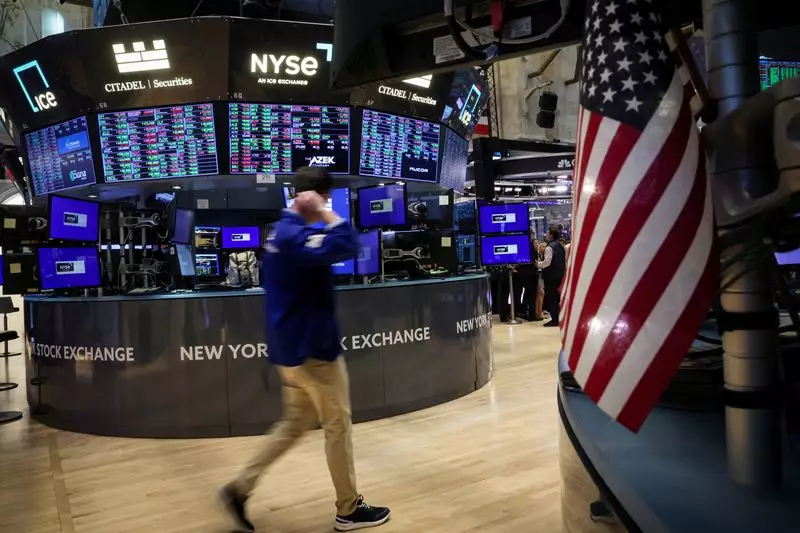In a striking week for financial markets, the Dow Jones Industrial Average and the S&P 500 reached record closing highs on Friday, fueled by a pronounced surge in technology stocks. Notably, Netflix’s strong quarterly performance served as a catalyst for broader technological gains, leading all three major indices to secure a sixth consecutive weekly gain, a feat not accomplished since late 2023. This robust performance signals optimism in the market, as investors continue to weigh the implications of economic data against corporate earnings.
During the week, the S&P 500 rose by 0.9%, the Nasdaq Composite increased by 0.8%, and the Dow Jones climbed by 1%. The most significant contributor to this upward momentum was Netflix, whose shares soared by an impressive 11.1% following the company’s announcement of exceeding subscriber growth expectations. Additionally, the streaming giant projected sustained growth into the final months of the year, which buoyed the sentiment in the communication services sector, lifting it by 0.9%. The tech-heavy Nasdaq also felt the positive impact, alongside gains in several other “Magnificent Seven” technology stocks, including Apple and Nvidia.
Market analysts have pointed to an array of favorable economic data, combined with a series of positive corporate earnings reports, as key drivers for this upward trend. David Waddell, CEO of Waddell & Associates, encapsulated the sentiment by stating, “It’s kind of the ‘what’s not to like’ market.” Indeed, the combination of disinflationary trends and optimism regarding company fundamentals has provided a solid foundation for investor confidence.
On Friday, the S&P 500 registered an increase of 23.20 points, closing at 5,864.67. Meanwhile, the Nasdaq Composite added 115.94 points to reach 18,489.55. The Dow Jones, while also achieving record highs, saw a more modest increase of 36.86 points, closing at 43,275.91. Notably, American Express’s 3.1% drop after reporting quarterly revenue that fell short of expectations served as a reminder of the volatility endemic to earnings season.
Despite this week’s achievements, concerns regarding elevated valuations linger in the background. With the S&P 500 trading at nearly 22 times forward earnings, analysts caution that high expectations for ongoing corporate performance might set the stage for a potential market correction. As Waddell noted, “We have gotten all we’re going to get from multiple expansion,” emphasizing that the sustainability of the current rally is now heavily dependent on earnings performance.
The proximity of the upcoming U.S. presidential election further complicates the market outlook. Potential political volatility could serve as a catalyst for unpredictability in stock prices; however, strong fundamentals might provide a buffer against such risks if anticipated corporate earnings materialize.
A closer inspection of sector performances reveals notable divergences. While most sectors climbed, energy was the sole exception, contracting by 0.4% due to falling oil prices and disappointing earnings from key players like SLB, which saw its stock price decline by 4.7%. This downturn impacted related companies, including Baker Hughes and Halliburton, underscoring the interconnected nature of commodity markets and equity valuations.
Interestingly, small-cap stocks have garnered attention from investors, with the Russell 2000 and S&P Small Cap 600 indices eclipsing their larger counterparts for much of the week. However, Friday’s trading showed a slight pullback in these indices, indicating that even amidst broad advances, select markets could face challenges.
While the week’s performance has been largely positive, the potential for shifts in market dynamics cannot be overlooked. CVS Health’s unexpected leadership change and the subsequent withdrawal of its 2024 profit forecast sent ripples through the healthcare sector, pulling shares down by 5.2%. This volatility emphasizes the need for investors to remain vigilant about corporate governance and forecasts as influential factors in market stability.
As trading volumes for U.S. exchanges hovered around 10.62 billion shares—less than the previous 20-day average of 11.56 billion—this could indicate a cautious approach from investors, aware of potential headwinds ahead. The anticipation of earnings—the backbone of this market rally—will be closely monitored in the upcoming weeks, as any deviations from expectations could provoke a reassessment of current market valuations. The enduring contention between bullish growth forecasts and underlying economic challenges suggests that the road forward could remain fraught with both opportunity and uncertainty for investors.

